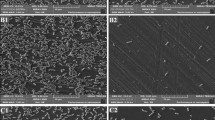Abstract
Listeria monocytogenes is a ubiquitously occurring Gram-positive bacterium, which is associated with raw ready-to-eat foods, in particular with smoked or graved salmon. Due to its tenacity and psychrotrophic growth properties, it may persist on the equipment and machinery used in food production. In this study, we analysed the survival of three L. monocytogenes strains in eight H1 lubricants, seven greases and one oil, applicable for food-processing machinery. None of the native lubricants contained Listeria spp. above the detection limit of 103 cfu/g. In artificially contaminated lubricants, the viable counts of different L. monocytogenes strains decreased by more than 99.9% within 7 days, and the reduction rates were found to dependent on the composition of the respective lubricant as well as on the L. monocytogenes strain. Chemical binding of either benzoate or acetate to native grease 3 caused a similar anti-listerial activity, but a decreased effect was observed when stearic acid was used. When benzoate, acetate, salicylate or parabene was added at a concentration of 0.5% to native grease 1, similar anti-listerial effects were observed. The water content (0, 1 and 5%) and the age of the lubricant did not influence the results. Used lubricants originating from dismantled industrial machinery did not contain L. monocytogenes, though this microorganism was re-isolated from the lubricants following artificial contamination. Thus, there is no evidence that L. monocytogenes replicate or persist in the H1 lubricants used in this study.

Similar content being viewed by others
References
Allerberger F, Wagner M (2010) Listeriosis: a resurgent foodborne infection. Clin Microbiol Infect 16:16–23
Anonymous (2011) The European Union summary report on trends and sources of zoonoses, zoonotic agents and food-borne outbreaks in 2009. European Food Safety Authority, European Centre for Disease Prevention and Control. EFSA J 9:2090
Uyttendaele M, Busschaert P, Valero A, Geeraerd AH, Vermeulen A, Jacxsens L, Goh KK, De Loy A, Van Impe JF, Devlieghere F (2009) Prevalence and challenge tests of Listeria monocytogenes in Belgian produced and retailed mayonnaise-based deli-salads, cooked meat products and smoked fish between 2005 and 2007. Int J Food Microbiol 133:94–104
Huss HH, Jørgensen LV, Fonnesbech-Vogel B (2000) Control options for Listeria monocytogenes in seafoods. Int J Food Microbiol 62:267–274
Miettinen H, Aarinsalo K, Salo S, Sjöberg AM (2001) Evaluation of surface contamination and the presence of Listeria monocytogenes in fish processing factories. J Food Prot 64:635–639
Thimothe J, Nightingale KK, Gall K, Scott VN, Wiedemann M (2004) Tracking of Listeria monocytogenes in smoked fish processing plants. J Food Prot 67:328–341
Carpentier B, Cerf O (2011) Review–Persistence of Listeria monocytogenes in food industry equipment and premises. Int J Food Microbiol 145:1–8
Chaitiemwong N, Hazeleger WC, Beumer RR (2010) Survival of Listeria monocytogenes on a conveyor belt material with or without antimicrobial additives. Int J Food Microbiol 142:260–263
Fonnesbech-Vogel B, Truelstrup Hansen L, Mordhorst H, Gram L (2010) The survival of Listeria monocytogenes during long term desiccation is facilitated by sodium chloride and organic material. Int J Food Microbiol 140:192–200
Fonnesbech-Vogel B, Huss HH, Ojeniyi B, Ahrens P, Gram L (2001) Elucidation of Listeria monocytogenes contamination routes in cold-smoked salmon processing plants detected by DNA-based typing methods. Appl Environ Microbiol 67:2586–2595
Rørvik LM, Aase B, Alvestad T, Caugant DA (2000) Molecular epidemiological survey of Listeria monocytogenes in seafoods and seafood-processing plants. Appl Environ Microbiol 66:4779–4784
Johansson T, Rantala L, Palmu L, Honkanen-Buzalski T (1999) Occurrence and typing of Listeria monocytogenes strains in retail vacuum-packed fish products and in a production plant. Int J Food Microbiol 47:111–119
Wulff G, Gram L, Ahrens P, Fonnesbech-Vogel B (2006) One group of genetically similar Listeria monocytogenes strains frequently dominates and persists in several fish slaughter- and smokehouses. Appl Environ Microbiol 72:4313–4322
Nakamura H, Tokuda Y, Sono A, Koyama T, Ogasawara J, Hase A, Haruki K, Nishikawa Y (2006) Molecular typing to trace Listeria monocytogenes isolated from cold-smoked fish to a contamination source in a processing plant. J Food Prot 69:835–841
Aarnisalo K, Sheen S, Raaska L, Tamplin M (2007) Modelling transfer of Listeria monocytogenes during slicing of “gravad” salmon. Int J Food Microbiol 118:69–78
Chen B-Y, Pyla R, Kim T-J, Silva JL, Jung Y-S (2010) Prevalence and contamination patterns of Listeria monocytogenes in catfish processing environment and fresh fillets. Food Microbiol 27:645–652
Rørvik LM (2000) Listeria monocytogenes in the smoked salmon industry. Int J Food Microbiol 62:183–190
Moens M (2003) Production and use of food-grade lubricants. Trends Food Sci Technol 14:157–162
Moon M (2007) How clean are your lubricants? Trends Food Sci Technol 18:S74–S88
Aarnisalo K, Raaska L, Wirtanen G (2007) Survival and growth of Listeria monocytogenes in lubricants used in the food industry. Food Control 18:1019–1025
Wernars K, Heuvelman K, Notermans S, Domann E, Leimeister-Wächter M, Chakraborty T (1992) Suitability of the prfA gene, which encodes a regulator of virulence genes in Listeria monocytogenes, in the identification of pathogenic Listeria spp. Appl Environ Microbiol 58:765–768
Acknowledgments
We thank Elkalub Chemie-Technik GmbH, Vöhringen, Germany, for providing us with the lubricants and the three-roll mill. We also thank Dr. Matthias Contzen of the Chemisches und Veterinäruntersuchungsamt Stuttgart, Germany, for the L. monocytogenes isolate CVUAS 6159.
Conflict of interest
The authors declare that they have no conflict of interest.
Author information
Authors and Affiliations
Corresponding author
Rights and permissions
About this article
Cite this article
Weiss, A., Wild, S., Lutz, AS. et al. Analysis of the survival of Listeria monocytogenes in food-grade lubricants. Eur Food Res Technol 234, 323–331 (2012). https://doi.org/10.1007/s00217-011-1638-y
Received:
Revised:
Accepted:
Published:
Issue Date:
DOI: https://doi.org/10.1007/s00217-011-1638-y




